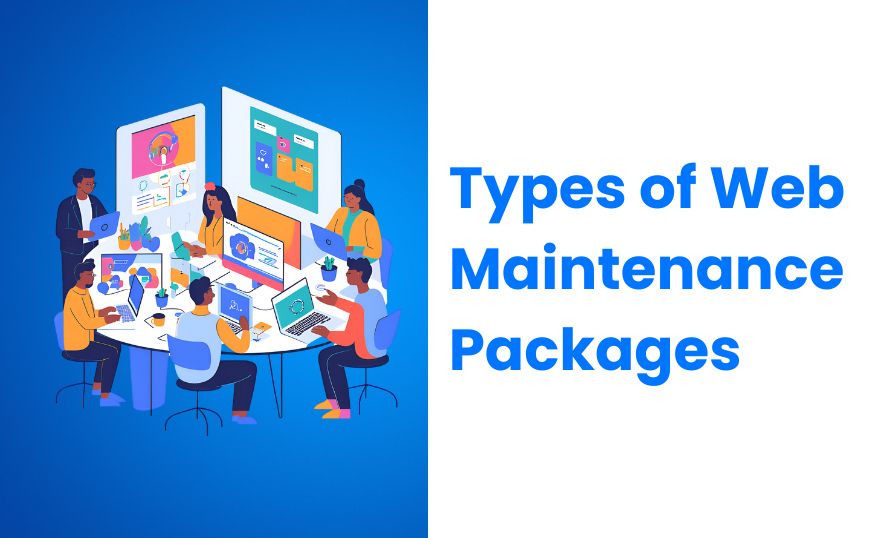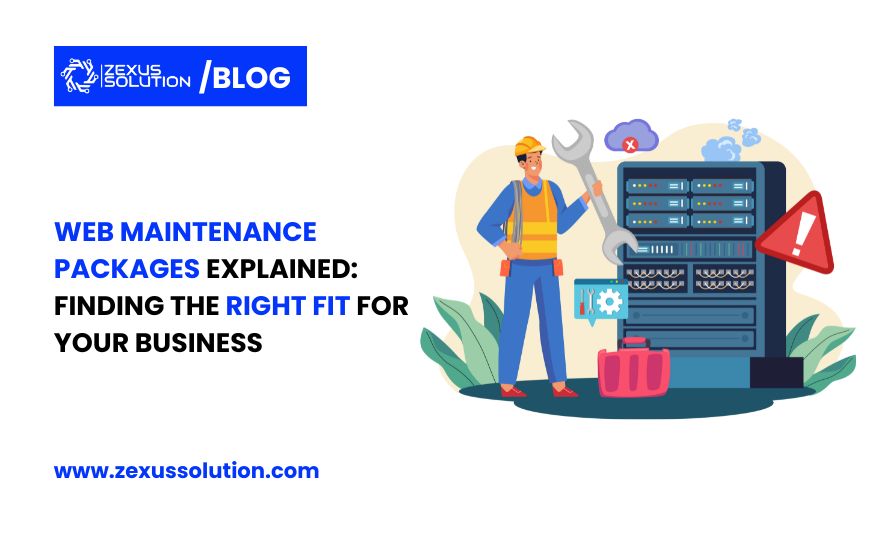Table of Contents
Web maintenance keeps your website secure and updated. An effective maintenance plan ensures that your website is optimized and vulnerabilities are avoided so that it follows the latest updates from browsers and security protocols. However, not every web maintenance package suits every business, since varying industries and business sizes call for different requirements.
For instance, the e-commerce sites would need regular updates in content, security scans, and transaction monitoring to sustain the trust of customers. In contrast, smaller information-based websites would be more performance and security update-based. Hence, it is necessary to choose a web maintenance package that meets your business goals, technical needs, and budget.
It’s not just about how much it costs, it is more about the long-run health of your digital presence. Proper web maintenance ensures you always have a smooth experience on your site, growing customer confidence, and therefore working for the growth of your business and online success.
Main Features of Website Maintenance Packages
Web application maintenance services include a core set of features that can be used for proper website maintenance. Common features are:
- Software Upgrades: Frequent upgrades for CMS, plugins, and themes to ensure security and functionality.
- Backup and Restore Services: There are frequent backups made on your data and if anything goes wrong, then restoring is possible.
- Security Scanning: Security scanning regularly and threat monitoring so your website remains safe.
- Performance Optimization: It involves speed testing and improvements on caching that help load up pages fast.
- Content Updates: The content is kept fresh, updated, and accurate on blogs or e-commerce sites.
- Technical Support: Access to experts in troubleshooting and fixing problems as they arise.
Types of Web Maintenance Packages:

Every kind of business has different needs when it comes to website maintenance. However, knowing the types that exist can help you find a suitable one that will assist in achieving your goals. That is based on your capacity, resources, and the complication level of your website. Here are some common kinds.
1. Basic Web Maintenance Package
This is the most basic level, suitable for small-scale businesses, bloggers, or simply a personal website that doesn’t require a lot of sophistication or frequent upgrades. A basic package of service would cover the important functions to keep the site safe and running without adding extra services.
- It will include basic software updating, security checks, restricted backup, minor content editions, and troubleshooting.
- Ideal for: Small business, personal, blogging, or portfolio sites generate little traffic or contain sensitive data.
Benefits
- Suitable for small budgets.
- It includes basic updates and security scans.
- Suitable for low-maintenance websites.
Drawbacks
- Has very limited features and support.
- Provides only minimal protection against cyber attacks.
- May not include SEO tracking and detailed analysis.
2. Standard Web Maintenance Package
A standard package usually suits mid-sized businesses or e-commerce sites with moderate traffic. These packages come with more extensive website maintenance services to ensure that the functionality is smooth and enhanced security measures.
- Regular software and plugin updates, bi-weekly backups, moderate security monitoring, performance optimization, and broken link repairs are included in this package.
- Ideal For: Small E-commerce sites, small to mid-sized businesses, non-profits, and informational websites that handle sensitive data or moderate traffic.
Benefits:
- Covers core maintenance needs with added security.
- Includes performance optimizations for better user experience.
- Provides some analytics and SEO monitoring.
Drawbacks
- More expensive than the basic packages.
- Could still be missing specialized support or extensive content updates.
3. Premium Web Maintenance Package
Premium packages cater to websites that have heavy traffic, functionality, or security demands. This package typically includes a wide range of services to ensure optimal performance and maximum protection.
- More frequent software updates, daily backup, advanced security monitoring which includes DDoS protection and SSL monitoring, heavy performance optimization, SEO analytics, content management, and custom feature support are included.
- Ideal For: Big e-commerce websites operating online, highly trafficked blogs and membership sites, or businesses dealing with confidential information about clients.
Benefits:
- There is full support with the emergency service included.
- The level of security is at its top as it has malware scan and DoS attack protection.
- SEO and analytics reporting for continuous improvements.
Drawbacks:
- More costly because all the services provided are a full-scale operation.
- Requires longer contracts with a focused support team.
4. E-commerce Website Maintenance Package
E-commerce websites require specific maintenance mainly because of the complexity entailed in shopping online, a secure checkout process, and real-time updates for inventories. An e-commerce website maintenance package usually entails customized services meant to safeguard, make it user-friendly as well as keep the store up-to-date.
- Real-time monitoring, payment gateway updates, product and inventory updates, security scans to protect customer data, speed optimization, and SEO tracking for product pages are included.
- Ideal for: E-commerce websites and online markets that have more than one listing in products or in payment options.
Benefits:
- Dedicated support for e-commerce functionalities.
- Regular security and PCI compliance checks.
- Product-specific SEO and performance optimization.
Drawbacks:
- More costly due to specialized e-commerce needs.
- Requires consistent updating due to changes in inventory and payment systems.
SEO-Driven Website Maintenance Package
This is ideal for companies looking to attain a higher rank in the search engines to attract more organic traffic, these SEO-driven packages focus on making the content, structure, and performance better and optimizing them so you are better ranked on the searches.
- Keyword monitoring, on-page SEO review, backlink tracking, content refreshing, frequent performance reviews, and mobile responsiveness are included.
- Ideal For: Content-based websites, online newspapers, blogs, and websites with organic SEO development through the same process.
Benefits:
- Continuous search engine ranking enhancements.
- Boosted visibility and engagement by users.
- Periodical reports of SEO audit analysis are delivered.
Drawbacks:
- Is centered mostly on SEO so could be lacking in sophisticated security and development capabilities.
- Can be pretty costly if the scope of services involved for SEO is wide-scale.
6. Custom Web Maintenance Package
In particular, business plans differ according to various specializations that they may want from those of the web maintenance packages that can’t already be packaged.
The important thing a customized plan offers is selecting all types of requirements that do not remotely fit inside the standard. While some businesses opt for industries they conduct, goal-specific planning, and technical specifics involved during performance, industry-oriented regulations are on different levels.
- It comprises a combination of typical feature sets, both tiers possibly up to including particular niche solutions or requests; and industry-oriented rules on different levels:
- Ideal For: Special needs of the business or complexly structured websites that are not likely to fit into standard packages, such as SaaS providers or very specific e-commerce sites.
Benefits:
- Customized solutions to meet specific needs and business objectives.
- Flexibility to add or remove services as required.
- Highly flexible to accommodate changing business requirements.
Drawbacks:
- Usually the most costly option.
- It requires deeper consultation and planning.
- Ongoing maintenance may require a dedicated team.
How to Choose Your Business’s Right Web Maintenance Package

When you are selecting a web maintenance package, there are key aspects you should consider to determine the best fit for your needs:
Determine Your Website’s Purpose and Complexity
The right plan depends on the purpose and complexity of your website. For instance, a simple blog or portfolio will require only a basic package, whereas an online store with payment processing and user accounts will require a more comprehensive plan with enhanced security.
Consider Your Audience and Traffic Volume
High-traffic websites need monthly website maintenance plans that offer frequent monitoring and optimization, ensuring smooth performance during peak times. If your customers depend mostly on your website, take a package with enhanced assistance and uptime guarantees.
Evaluate Security Needs
For sites that contain sensitive information, especially of customers and payment gateway, high security is inevitable. Choose packages that incorporate features like SSL monitoring, malware scanning, and firewalls for protection against cyber crimes. Added security in those plans can be priceless, especially for e-commerce and membership-based websites.
Consider How Often the Content Will Change.
Consider how frequently you update your website. Companies that upload content on a regular basis, like news sites or e-commerce websites with dynamic inventory, would need to look for packages that allow for periodic updates and content optimization monitoring for continuous SEO.
Budget Limitations
In general, the most important aspect is to find a package that fits your needs and does not break the bank. So, how much does website maintenance cost? It varies, but startups or small businesses usually start at the basic or standard package, then scale up as the website needs to grow.
The alignment of your maintenance plan with your website’s goals, audience, and growth potential ensures it remains secure, up-to-date, and ready to support your business effectively.
DIY or Professional Web Maintenance: What’s Best for You?
For simple sites and individuals with web development experience, a DIY approach will be quite good enough, however, a business, which is having a complex site with high traffic may find a maintenance plan for the website invaluable. Professional web maintenance can handle issues quickly and ensure proactive security and performance measures, much more reliable than the DIY approach, and they know exactly what website maintenance includes to keep your site in optimal shape.
Final Thoughts: An Investment in Your Website’s Future
While cost may be one thing, investing in your future on the web is about a lot more than cost. Many businesses ask, “How much does website maintenance cost?” Prices vary widely, but by selecting a package that aligns with your business’s unique requirements, you’re safeguarding your website’s functionality, user experience, and overall reputation. It lays down a pretty good foundation to grow and succeed in business, all the while keeping the right package in place.



Add a Comment